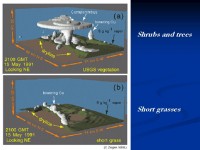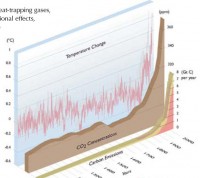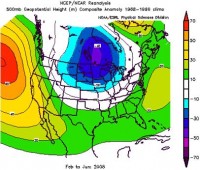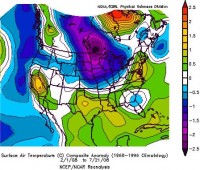
|
Aug 15, 2008
Deforestation Behind Loss of Mt Kilimanjaro Snow
By Felister Peter, IPPMedia
A scientific theory has linked the loss of snow on Mount Kilimanjaro to deforestation and dismissed suggestions that the dwindling of glaciers on Africa’s highest peak was due to global warming.
The theory is highlighted in a recent study report compiled by two researchers from Britain’s Portsmouth University, Nicholas Pepin and Martin Schaefer, who surveyed the mountain’s glaciers for 11 days. The researchers, who revealed their findings at a news conference in Dar es Salaam yesterday, said the mountain’s glacier surface had shrunk from 20 km in 1880 to a mere two kilometres in 2000.
They said the development was caused more by local than regional factors, with Pepin suggesting that deforestation mainly due to extensive farming as the major cause. “Deforestation of the mountain’s foothills is the most likely culprit because without forests there is too much evaporation of humidity into outer space. The result is that moisture-laden winds blowing across those forests have become drier and drier,” he explained.
“Loss of humidity automatically leads to a reduction in cloud cover. Clouds play a crucial role in protecting ice from sunrays, with fewer sunrays meaning faster freezing of water,: he added, citing reduced precipitation as another reason for the receding ice cover on the mountain’s summit.

See larger image here
Last year, another study on the dwindling ice cover on the mountain`s cap suggested that global warming had nothing to do with the alarming loss of its beautiful snows. The scientists who conducted the study, US-based Philip Mote and Georg Kaser, assertively linked the problem to a process known as sublimation. Revealing the findings they first published last year in the American Scientist magazine, the experts cautioned that using Mount Kilimanjaro as a “poster child” for climate change was awfully inaccurate.
In remarks at yesterday`s news conference, Journalists Environmental Association of Tanzania chairman Deo Mfugale also linked the loss of glaciers on Mount Kilimanjaro to human activities rather than global warming. He called for an end to the random felling trees and burning forests, mainly done for charcoal and timber, saying these and related practices led to the destruction of some 15 per cent of forests in Tanzania between 1976 and last year. Read more here.
Aug 06, 2008
CCSP Climate Impacts Report: A Perversion of Science
By Chip Knappenberger, World Climate Report
Luckily, the U.S. Climate Change Assessment Report just released by the U.S. Climate Change Science Program (CCSP) is only a “draft” released for the purpose of gathering public comments. This means that the report’s authors still have time to get things in order before a “final” publication is released. The current contents read as if the CCSP authors set aside their list of sizable scientific credentials, and instead opted to write a fantasy piece on how they wished the state of climate science to be, rather than how it actually is.
As it now stands, the draft CCSP report is a gross perversion of science. It is made even worse that it is coming from a group researchers, who, at one time at least, were regarded as some of the leaders in their fields. No fair treatment of science discusses a topic with complete disregard to opposing views that are held and published by other credible, qualified and knowledgeable persons. And yet this is precisely what is contained, ad nauseum, within the draft of the CCSP synthesis report.
The report reads as a simple rehashing of the “pet opinions” held by its authors and completely ignoring that these opinions have been harshly disputed and criticized in the scientific literature and elsewhere by other equally qualified researchers as being based upon faulty methodology and inappropriate inferences. It is as if the CCSP authors think that if they just keep repeating the same things over and over again in different fora, they will eventually become true-or at least that the critics will have become so exasperated by their audacity and simply grow tired of responding.
I am at a loss for complimentary adjectives to describe people who are tasked by the U.S. government with assessing climate change and its potential impacts on the United States for the clear (although unstated, wink, wink) purpose of influencing policy and who know of legitimate scientific viewpoints which counter their own but yet act as if such opposition entirely doesn’t exist. I have never read a more pessimistic report on climate change (other than perhaps coverage of Al Gore’s we-are-going-to-make-the-earth-uninhabitable-for-people proclamations)-and this coming from a supposed august scientific body. There are virtually no positive aspects of climate change presented or even postulated. Any that are briefly touched upon are almost inevitably countered with subsequent text along the lines of “but that effect will only be temporary.”
What kind of people think that the population of Americans will only suffer if the climate heats up by a few degrees? If you were to track the ‘average temperature’ experienced by the ‘average American’ over time (which we did in an analysis a few years ago), based upon population movements alone, you would find that the experiential temperature is increasing at a rate that is greater than many of the projected scenarios of climate change. In other words, the population movements made by American’s free will-primarily movements to more urban centers and southerly locales-has resulted in the ‘average American’ experiencing a climate that is about 3 degrees F warmer at the end of the 20th century than at the beginning-and that doesn’t even take into effect the inherent added warmth in urban environments. These changes are independent of actual climate changes.
See maps of the experiential and actual temperature changes and read much more in this stinging but on the mark commentary on this pervsion of real science here.
Aug 05, 2008
Chucky and the U.S. CCSP
By Steve McIntyre, Climate Audit
Last year, I reported on the resurrection of Chucky, with even Mann’s PC1, repudiated by Wegman and the NAS Panel, being illustrated in IPCC AR4. Chucky is back with a vengeance in the U.S. CCSP report, entitled “Unified Synthesis Product Report by the U.S. Climate Change Science Program and the Subcommittee on Global Change Research”, released in July 2008 for comment here , full report pdf here (33 MB); comment submission here. The report states that it is classified as “highly influential”.
On the second page of the running text of the report (pdf page 19, following the executive summary and many colorful pictures), we see the following graphic with the caption shown beneath it:

Original Caption: This 1000-year record tracks the rise in carbon emissions due to human activities (fossil fuel burning and land clearing) and the subsequent increase in atmospheric carbon dioxide (CO2) concentrations and air temperatures. The earlier parts of the Northern Hemisphere temperature reconstruction shown here are derived from historical data, tree rings, and corals, while the later parts were directly measured. No source is given for this graphic, but CA readers will recognize this as, using Hu McCullough’s phrase, “MBH with whiskers”.
It is the Mann reconstruction spliced with CRU temperatures in an interesting way. The graphic below shows the splice of the MBH98-99 proxy data up to 1901 with the CRU version archived in connection with MBH98, which opportunistically included instrumental data from warm 1998 after the actual publication of MBH98 (see script in first comment for splicing). In a commentary at RC, Pierrehumbert, stated: there is no legitimate reason in a paper published in 2007 for truncating the temperature record at 1992 as they did. However, I guess that in Team-world it’s OK for a paper published in 2008 to truncate the temperature record in 1998.
I also did a word search on “benefits” to see whether climate change in the U.S. was such an ill wind that it brought no “benefit” to anyone. Well, there were a few exceptions: “weeds, disease and insect pests” were noted as benefiting from warming and, in the case of weeds, also from higher CO2 levels. Read full post and note about one of the images enhanced in “photoshop” here. See more on how NCDC Goes Hollywood in this Watts Up With That post.
Aug 05, 2008
Winter and Spring Showed High Degree of Persistence
By Joseph D’Aleo, CCM, Fellow of the AMS on WSI’s Intellicast
The winter and spring showed a great deal of persistence which is why anomalies were so large. Persistence tends to be high during stronger La Ninas and El Ninas as we have reported earlier. Solar minimums also tend to exhibit less variability as the 27 day solar cycle still evident at the minimum is not strong enough to produce pulses in the atmospheric teleconnections like the PNA and NAO as they do when the sun is more active with flares and eruptive disturbances. Look at the upper level pattern for the last 6 months.

See larger image here
You can see clearly a central North America trough and ridges off the west coast and a weaker one off the east coast. The corresponding surface pattern has had the polar front in the mean dipping into the central states.

See larger image here
This is where the coldest air has been most persistent as would be expected.

See larger image here
Storms moved along the boundary bringing heavy rains and flooding, heaviest from the central states into the northeast. High soil moisture provided a positive feedback to the cool and wet pattern just as dryness in the southwest helped perpetuate warmth and dryness there. All this even as La Nina faded. Severe weather also occurred with these storms producing frequent tornadoes and more deaths than in recent years. We discussed earlier in this is story how this is typical of La Nina. 120 have died as of 27th July. This is tragic but falls far short of the well over 300 that died in the big La Nina outbreaks of 1965 (Palm Sunday) and 1974 (the Superoutbreak) or the 800 that died in 1927. Of course part of this decline is the improved awareness and the onset in the 1950s of severe weather forecasts and warnings. However, if indeed we have moved into a cold PDO era with more La Ninas as we and others believe, we can expect more active tornado seasons.
We can as we also discussed in this April story, expect more cold northern snowy winters, more spring floods, summer heat and drought in La Nina onset years, more Atlantic basin and east coast landfalling hurricanes. See full story with more graphics here.
Aug 04, 2008
Clearing the Smog of Beijing with “Coal by Wire.”
By Viv Forbes, Chairman of the Carbon Sense Coalition
As the TV turns nightly to Beijing, we can expect chilling pictures and doomsday comments about the “Asian Pollution” and the “Beijing Smog”. This will induce media and political scaremongers to use these images to sell dud products like the “Carbon Pollution Reduction Scheme”. It is not carbon dioxide from burning coal that pollutes the skies of Asia and Africa. Carbon dioxide (CO2) is a naturally occurring, clean, invisible, beneficial gas. CO2 is an essential part of the natural world but a very minor trace constituent of our atmosphere. This trace amount of CO2 in the atmosphere is the aerial food store for all plants, and thus also sustains all animals, including humans. CO2 is a boon to life, not a pollutant.
Moreover, the claim that man’s emissions will cause dangerous global warming is strongly and increasingly disputed by scientists and is not supported by historical evidence. It also defies common sense to believe that such a minor natural gas can cause all the climate disasters that are blamed on it. We are about to hang an innocent hero. Asia’s visible pollution is largely caused by the crude and inefficient open air combustion of low quality fuels. It is caused by millions of open-air cooking fires in India, China, North Korea and Africa using scavenged fuels like cow dung, cardboard, wood, and low quality coal and coke; by thousands of backyard brickworks and small dirty furnaces along the Yangtze River and in other places; by forest clearing fires in Indonesia and bush and grass fires elsewhere; and by millions of small obsolete and dirty wood, charcoal and coal stoves, heaters, boilers and furnaces all over Asia and Africa. Similar pollution is obvious in places in South America. “Open fires” was the cause of similar smogs in England as recently as the 1950’s.
Open-air combustion of poor quality carbon fuels produces not only the harmless clean so-called “greenhouse” gases of water vapour and carbon dioxide, but also real pollutants such as soot, smoke, ash, dust, unburnt fuel and chemicals containing sulphur, chlorine, nitrogen, fluorine, and metals. In confined unventilated places, open fires can also produce the very poisonous gas, carbon monoxide - this is the one that will quickly kill the canary. China also emits more sulphur dioxide than anywhere else in the world. This chokes their people, causes acid rain and damages buildings.
England’s last and worst ever pollution event, “The Black Fog” of 1952, was triggered by a temperature inversion over London. Visibility was reduced to less than one foot and 4,000 Londoners died from SO2 poisoning (50 in one small London park alone). This shock brought action. Two things cleared the Big Smoke from London and Manchester. Firstly was the passage of the Clean Air Act in 1956 - cooking and heating with open fires of wood and coal was banned in big cities. But bans would not have worked without other better heating options. No matter what the laws say, people will use whatever fuel they can find to keep warm and cook their food. Londoners only stopped burning wood and coal in their homes when electricity and smokeless fuel came available. The government encouraged people to use electricity - it was called “Coal by Wire”.
This clean energy can be generated reliably 24 hours a day, using high quality coal in non polluting power stations located far from densely populated areas. It is then transported silently and cleanly with zero pollution and minimal loss of energy to deliver lighting, heating, cooling, cooking and motive power into the most humble home in the poorest suburb. It is the magic of the modern world. Today’s irrational and hysterical focus on harmless carbon dioxide by governments and media is misdirected and counter-productive. It is diverting attention and resources from damaging pollution which is altering local climate and affecting many areas of the world. And it is delaying the spread of coal powered electricity to many areas now desperate for clean invisible power. Read more here.
|
|
|
|







